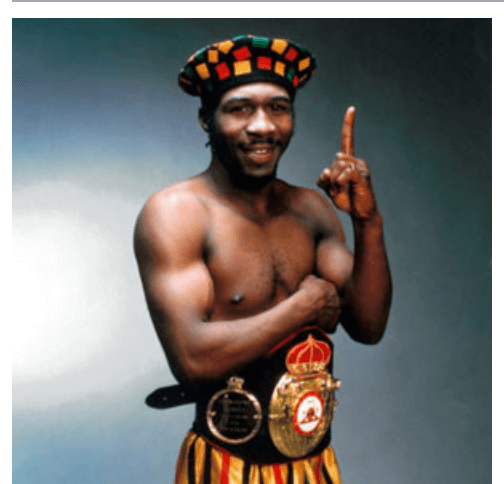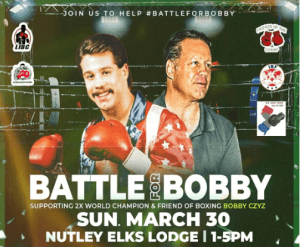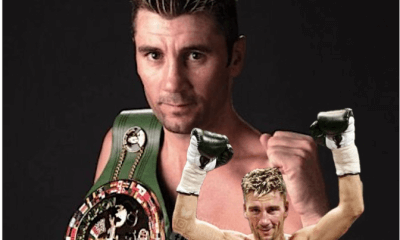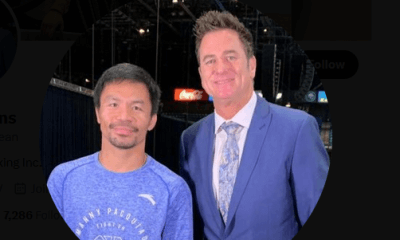Featured Articles
Boxing Odds and Ends: The Wacky and Sad World of Livingstone Bramble and More

One couldn’t write a book about prizefighting’s most eccentric characters without including former lightweight champion Livingstone Bramble who passed away last Saturday (March 22) at age 64 in Las Vegas. The Bramble chapter might well be the longest chapter in the book.
Born on the island of St. Kitt’s and raised in St. Croix, Virgin Islands, Bramble had his first 22 pro fights in New Jersey, nine at Ice World where he made his pro debut. A 3,000-seat hockey rink in Totowa, a community in Northern New Jersey roughly equidistant between Newark and Paterson, Ice World was the stomping ground of Main Events, a family-run enterprise founded by former labor lawyer Dan Duva, the oldest son of colorful boxing trainer Lou Duva who was effectively the face of the operation.
Bramble burst into prominence on June 1, 1984, when, in his twenty-third pro fight, he upset Ray “Boom” Mancini at Buffalo’s War Memorial Auditorium, taking away Mancini’s WBA world lightweight title.
Referee Marty Denkin stopped the fight in the 14th stanza with Boom Boom on his feet but in very bad shape. Bramble dominated the second half of the fight but was yet trailing on two of the scorecards, a potential scandal that was averted when he took the fight out of the judges’ hands. They fought again 11 months later in Reno and Bramble won a narrow but fair 15-round decision, out-pointing Mancini by 1 point on all three cards.
Bramble’s eccentricities overshadowed his feats in the ring. He owned a boa constrictor named Dog and a pit bull terrier named Snake. A Rastafarian, he trained with reggae music in the background, braided his hair before it was fashionable, and began his public workouts by having his trainer blow soap bubbles which he popped with his fists. Prior to both Mancini fights, he had a voodoo witch doctor place a hex on Boom Boom (the man was exposed as Bramble’s former middle school basketball coach).
After the second Mancini fight, Bramble successfully defended his title with a 13th-round stoppage of Tyrone “Butterfly” Crawley, but he was then shocked by Edwin Rosario who became a lightweight champion for the second time when he knocked out Bramble in the second round at an outdoor stadium in Miami Beach. Rosario’s upset spoiled a lucrative unification fight between Bramble and Hector Camacho.
Attempting to fight his way back into title contention, Bramble never did get over the hump. His best win as a former champion was a second-round knockout of junior welterweight Harold Brazier, a boxer who would be stopped only one other time, that coming late in a 124-fight career. Bramble took that fight on nine days’ notice, subbing for Micky Ward who pulled out with a hand injury.
Bramble eventually devolved into a gatekeeper, a diplomatic term for a professional loser. He won only three of his last 16 fights to finish 40-26-3.
Late in his career, Bramble settled in Las Vegas. He was 41 years old when he made his first and only ring appearance in his adopted hometown. It came at the Orleans, an off-Strip property where he was paired against Guadalajara journeyman Juan Carlos Rodriguez who had lost seven of his previous nine heading in. At the time, Bramble was preparing for his life after boxing by taking a class for aspiring slot machine technicians.
Bramble lost a wide 10-round decision. “[He] couldn’t get his jab working or put his punches together in a disappointing performance,” wrote Review-Journal ringside reporter Royce Feour. The bout’s matchmaker Brad Goodman was more scathing in his assessment. “Bramble should retire,” said Goodman. “He can’t pull the trigger. His mind was telling him to do something, but his body was not reacting.”
Bramble had four more fights, the last two 6-rounders on small cards in Idaho and Utah. All told, he answered the bell as a pro for 498 rounds.
Jacob “Stitch” Duran, boxing’s most prominent cutman, was new in town and scrounging for work when he first met Livingstone Bramble. They met at the long-shuttered Golden Gloves gym.
“I approached him and asked ‘when is your next fight?’” recalled Duran. “He looked me in the eye and said, ‘right now if you don’t shut up.’”
Duran was taken aback, but then Bramble smiled his radiant smile and Duran knew he was being spoofed. He would eventually work the pads for Bramble and the two became fast friends.
Livingstone Bramble spent his final years in an assisted living facility in Las Vegas, the cost of which, notes Duran, was born by the World Boxing Council which has a fund set aside to assist former professional boxers who have fallen on hard times.
Duran had a habit of visiting Bramble every week but stopped when the boxer could no longer recognize him. “I told his son that I just couldn’t do it anymore, it was too heartbreaking, and that I wanted to remember his dad the way that he was,” Duran told this reporter. “His son was very understanding.”
Stitch Duran remembers the exact time when he was informed that his friend had died. The call from Bramble’s son came at 3:44 in the morning.
News travels fast in the digital age and after Las Vegas fight writer Kevin Iole shared the news of Bramble’s departure on his website, other news outlets quickly latched hold of the info. What’s missing is a formal obituary and funeral arrangements. As yet, there are none.
Bobby Czyz
Livingstone Bramble and Bobby Czyz were stablemates whose careers ran on parallel paths and sometimes intersected. Both earned their spurs on Main Events promotions at Ice World.
The headline attraction on the card where Livingstone Bramble made his pro debut was a match between Bobby Czyz and Tommy Merola, young middleweight prospects. He and Bramble were on the same bill again the following year. The May 21, 1981 event was reportedly the first advance sellout of a boxing card in Totowa.
The brainy Czyz, who finished sixth of 365 in his high school graduation class according to a story in the New York Times, went on to win world titles as a light heavyweight and a cruiserweight. He had a promising career as a Showtime boxing commentator when he hung up his gloves.
Czyz lost that gig (we won’t elaborate) and things went downhill from there. In the summer of 2018, he was discovered working as a cashier in a New Jersey grocery store by a reporter for the Newark Star Ledger.

In December of last year, Bobby Czyz, now 63 years old, was diagnosed with brain cancer. And that brings us to this Sunday (March 30) when a benefit will be held for Czyz at the Elks Lodge located at 242 Chestnut Street in Nutley, New Jersey. A number of boxing luminaries of yesteryear will be in attendance at the event which commences at 1 pm. Tickets to the fundraiser, which are tax-deductible, start at $100.
At last look, the event was a near-sellout. Those interested in attending or just supporting Bobby in this battle should go to this website: https://www.eventbrite.com/e/battle-for-bobby-czyz-tickets-1243505882569
To comment on this story in the Fight Forum CLICK HERE
-

 Featured Articles3 weeks ago
Featured Articles3 weeks agoResults and Recaps from New York Where Taylor Edged Serrano Once Again
-

 Featured Articles3 days ago
Featured Articles3 days agoThe Hauser Report: Zayas-Garcia, Pacquiao, Usyk, and the NYSAC
-

 Featured Articles2 weeks ago
Featured Articles2 weeks agoResults and Recaps from NYC where Hamzah Sheeraz was Spectacular
-

 Featured Articles3 weeks ago
Featured Articles3 weeks agoFrom a Sympathetic Figure to a Pariah: The Travails of Julio Cesar Chavez Jr
-

 Featured Articles3 weeks ago
Featured Articles3 weeks agoPhiladelphia Welterweight Gil Turner, a Phenom, Now Rests in an Unmarked Grave
-

 Featured Articles1 week ago
Featured Articles1 week agoManny Pacquiao and Mario Barrios Fight to a Draw; Fundora stops Tim Tszyu
-

 Featured Articles1 week ago
Featured Articles1 week agoArne’s Almanac: Pacquiao-Barrios Redux
-

 Featured Articles4 weeks ago
Featured Articles4 weeks agoCatterall vs Eubank Ends Prematurely; Catterall Wins a Technical Decision


















